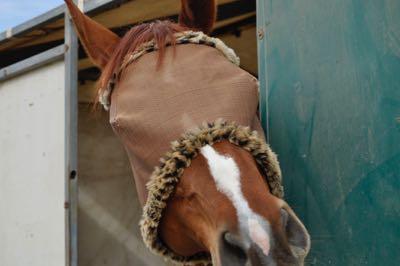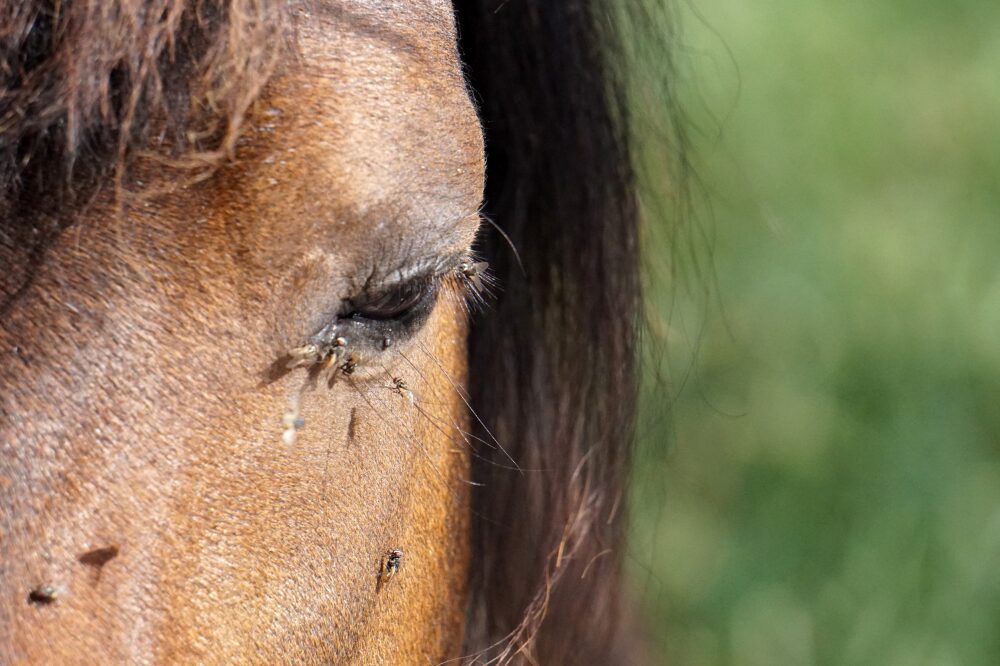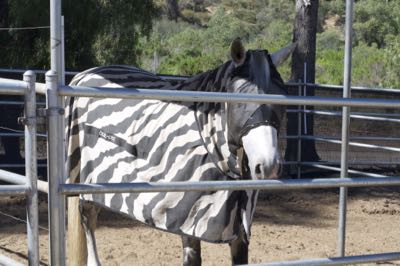Treat the Barn and Horse - Fly Control for Horses
Flies are a significant pain in the butt – and can be irritating. Luckily, there are many things to do around the farm and barn that can be helpful. First, we must understand how flies live, breed, and what motivates them. Although there are a zillion types of flies, for simplicity’s sake, we will lump them all together into the blood-sucking stable fly variety. These are the most annoying to horses and feed on blood.
Table of Contents

Fly Control for Horses Begins Where Flies Live
- Insects are attracted to smells and sights, and in the barn, that usually means near manure and urine. The fly populations will explode without proper manure management.
- First, try to remove the source of flies at the barn – the soft, moist, decaying organic matter. Usually, this is manure, but it can also be urine-stained bedding or any other decaying organic stuff.
- Manure is where flies breed and their eggs mature. Get rid of manure, get rid of flies. Yes, many of us compost the manure (which is excellent!), and fortunately, this is okay. You are fine as long as the manure is removed from the barn, allowed to compost, and dried. Flies like the wet stuff.

Know the Insects – Mosquitoes, Flies, Ticks
Knowing the type of insect is key, too. Here are the most common types of adult flies and insects around horses, and some quick tips on how they live and what they like. Then you can determine what protocols to deploy and where. Some flies you fight in the stalls, some flies you fight in the paddocks.
House flies
- Attracted by: Decaying organic matter, garbage, manure, sugary substances, food scraps.
- Preferred living: Warm environments, often around human habitation, like the sun, but rest in shaded areas. Thrive in moist, unsanitary spots where they lay eggs.
- What you can do: Keep trash sealed, clean manure promptly, fly traps or sticky ribbons, insecticides if needed, and maintain good sanitation.
- More active at dawn and dusk.
Horse flies
- Attracted by: Movement, dark colors, carbon dioxide, warmth (blood meals).
- Preferred living: Near water or moist areas; sunny but rest in shade.
- What you can do: Fly sheets and masks, insect repellents, black ball traps, and manage wet areas to reduce breeding.
- Usually bite during bright, sunny daylight hours, especially around midday.
Greenhead flies (a type of horse fly)
- Attracted by: Salt marshes, decaying seaweed, moisture near coastal areas, and seek warmth for blood meals.
- Preferred living: Coastal salt marshes with sunny, humid environments; larvae develop in wet mud or marshy soil.
- What you can do: Avoid marshy areas during peak times (daytime hours), use insect repellents, wear protective clothing, and use fans or traps near outdoor areas.
Deer flies
- Attracted by: Movement, dark colors, CO2, body heat for blood meals.
- Preferred living: Wet, wooded/shaded areas near water; larvae in moist soil or water margins.
- What you can do: Protective clothing, repellents, avoid peak times, and biting fly traps. Try one of the dragonfly hat attachments.
- Usually bite during bright, sunny daylight hours, especially around midday.
Horn flies
- Attracted by: Cattle, frequent blood meals.
- Preferred living: On livestock; eggs in fresh manure.
- What you can do: Clean pastures, use insecticide ear tags or pour-ons, and practice pasture rotation.
- Bite throughout the day when cattle are active, often in sunny conditions.

Black flies
- Attracted by: Flowing water for breeding; blood meals from mammals and birds.
- Preferred living: Near fast-flowing streams/rivers; larvae in oxygen-rich water. Adults like shade or woods.
- What you can do: Avoid peak times/places, use repellents, wear protective clothing, and apply insecticide at breeding sites.
- Typically bite during daylight hours, with peak activity mid-morning to late afternoon.
Mosquitoes
- Attracted by: Standing water (breeding), carbon dioxide, body heat, and sweat odors.
- Preferred living environments: moist areas, stagnant water pools, and shaded, humid areas.
- What you can do: Eliminate standing water, use mosquito dunks or larvicides, repellents containing DEET or picaridin, and nets/screens to disrupt flying.
- Most active at dawn and dusk, though some species bite during the day or night.
Gnats
- Attracted by: Moist soil, decaying plants, fermenting fruits, sometimes sweat or body oils.
- Preferred living: Damp, shady environments with organic matter.
- What you can do: Reduce moisture, clean up organic debris, use screens in barns during peak times, fans to deter them.
- Most active at dawn and dusk.
Ticks
- Attracted by: Warm-blooded hosts, CO2, body heat, movement.
- Preferred living: Tall grasses, wooded areas, leaf litter, shaded moist environments.
- What you can do: Wear protective clothing, use tick repellents (permethrin on clothes, DEET on skin), keep grass trimmed, remove ticks promptly, and treat pets with tick preventatives.
Fly Control for Horses – Treat the Barn and Farm Environment
Start with your farm’s most lucrative commodity – the manure. Then move on to other areas of the farm.
Manure management – focus on moisture
- The sun is great for drying out manure. Flies love to lay their eggs there, where they hatch into larvae on their way to becoming your horse’s most annoying pest. The better manure management practices you have, the fewer flies you’ll have.
- If you compost, that’s also an excellent place for eggs to perish, especially if the top layer dries out in the sun. If it remains moist, you should relocate the compost bins away from the barn and paddocks.
- Wet shavings and dropped food also attract flies, so keep feeding areas and shavings clean and dry. Zeolites (like Sweet PDZ) are great for keeping moisture and ammonia away.
Insecticides for the barn area
- You can use perimeter sprays in the barn. EcoVet has a particularly odd smell, but it will camouflage the area and help keep some flies away. It’s suitable for stalls.
- For larger areas, use permethrin and pyrethrum sprays, or natural fly sprays with essential oils. Citronella spray is popular, especially for mosquitoes.
- However, some ingredients are downright deadly to cats, so check before you spray. Fly sprays containing certain insecticides, such as pyrethrins and pyrethroids, and especially permethrin, are highly toxic to cats.
- Automatic misting systems involve a large barrel of insecticide, attached to hoses and spray nozzles inside a barn. They release a spray on a timer. Verify that no barn cats or dogs can be harmed before you go this route.

This fatty acid spray is designed for legs and bellies and lasts quite a bit, and is great for spraying around stalls.
Wasps are fly predators
- Mail-order wasps known as fly predators eat insect larvae around the property. Your recurring shipment of wasps is custom to suit the size of your farm. It’s best to start using these weeks before you notice adult flies.
- It’s biological fly control for horses in the mail!
Proximity to livestock
- If possible, keep your horse away from cattle. Not only are some cow feeds with monensin highly toxic to horses, but those cows also attract flies. It’s not always possible to create enough distance from livestock, but you can strategically place traps between horse and livestock areas to minimize the risk.
Ventilation and wind
- Fans of the automatic shut-off variety help keep fresh air flowing and make it harder for flies to bother the horses. If you need to have your horses in the barn, consider using screens as a physical barrier for horses with severe allergic reactions to flies. You may not be able to screen everything, such as barn doors, but enclosing a stall is relatively easy.
Using traps as fly control for horses
- Smelly traps are easy to use, and if you place them away from your horse, you’ll lure the flies there. Larger flies, such as greenheads and horseflies, do best with standing traps that mimic their target, placed in open spaces.
- Smaller sticky traps and tape can help in a stall, unless there are bird nests. In which case, use a sticky trap in a cage to prevent our winged friends from getting stuck.

Zebra prints are said to be less attractive to flies. And definitely more fashionable.
Treat Your Horse
- Now focus on your horse. You can treat them both inside and outside, if you prefer.
Supplements and feed-through products
- Feed-through fly control supplements can be one of two types of biological control options for flies.
- One type contains insecticides called insect growth regulators (IGR). These chemicals pass through your horse and land in the manure. When fly eggs hatch in that manure, they can’t develop into adult flies. Look for chemical insecticides with ingredients such as diflubenzuron, cyromazine, and novaluron. All are deemed safe for horses by the EPA.
- Another group of feed control doesn’t contain chemicals, but instead various ingredients like diatomaceous earth (DE), grape seed extract, garlic, and the like. Incidentally, garlic is toxic to horses, and there’s little evidence that DE has any beneficial effects on horses.
- You’ll need to start using feed-through products in late spring or earlier. Aim for about 6 weeks before the usual start of fly season.
Fly repellent sprays
- Fly sprays are composed of several types of ingredients, including repellents, insecticides, carriers, fragrances, conditioners, and additives to prolong the effectiveness of the active ingredients. Some sprays utilize natural pyrethrins derived from chrysanthemum flowers, while others employ synthetic pyrethroids, such as permethrin, which last longer but can be toxic to aquatic life.
- Oils like peppermint and citronella are common natural repellents, but they may not completely stop all biting flies.
- Applying fly spray safely means using mitts or roll-ons on sensitive areas. Combining sprays with fly sheets or masks gives the best protection. Homemade sprays can work, but avoid toxic oils or household cleaners, and always watch for skin reactions, especially on horses with sensitive skin. If irritation occurs, rinse thoroughly and contact your veterinarian.
- Peppermint oil and apple cider vinegar are two popular ingredients for homemade fly sprays.
- There is also a new breed of fly control product out there – fatty acid-based sprays. These funny-smelling sprays camouflage your horse and confuse the flies, so they can’t “find” your horse. Spiffy. Be sure to read the instructions!
Make your own fly spray instructions here!
Boots, sheets, and masks are easy fly control for horses
- Dress your horse up in fly gear for best results.
- Fly boots protect delicate skin, help deter mud, and reduce stomping, which can damage hooves over time.
- Fly sheets can cover your horse from head to tail if sweet itch (also known as insect bite hypersensitivity or IBH) is an issue. Zebra prints can confuse flies, helping keep them away.
- For fly masks, ideally, the ears and nose are covered. Noses get a little UV protection, too, that way.

This twisty tool is ideal for snagging ticks without touching them.
Tick prevention
- These little pests love shady, humid spots with tall grass and woods, so keeping pastures and trails mowed and tidy helps a lot. Managing rodents and considering natural predators, such as chickens, can also reduce tick populations. However, some tick species are attracted to birds, so it’s essential to research your area first.
- For horses, clipping legs makes it easier to spot ticks, and vet-recommended pesticides like permethrin or Frontline sprays are most effective in killing ticks quickly. Always check your horse after rides, focusing on tricky spots, and remove any ticks carefully with proper tools like one of those twisty tick things.

In the barn, you can also use your fans as fly control – some more double-duty! Flies have a hard time landing on your horse in the wind, and in the barn, fake it with fans.
Videos


FAQ’s
What are the most effective methods for fly control in horses?
You'll need to treat the barn and your horse, attacking all stages of the fly life cycle. Keep manure and dirty shavings managed so flies won't lay eggs there. Then treat for larvae with fly predators, and keep your horse covered with fly sheets and fly boots.
How do flies affect the health and well-being of horses?
Flies are a source of irritation, causing horses to stomp, which can often damage their hooves. Flies also carry diseases, from viruses that create aural plaques in ears, to encephalitis (EEE), transmitted by mosquitoes. Biting flies like greenheads and black flies feed on blood, which is painful, itchy, and may become infected.
What natural remedies can be used for fly control on horses?
Homemade fly sprays with apple cider vinegar and essential oils are popular. Homemade fly traps that lure flies into inescapable containers can be made from soda bottles and some rotten fruit to attract flies away from the horses.
When should you start fly control for horses?
Before fly season starts, you can use feed-through fly control supplements and start to spread fly predators around the paddocks and barn. As fly activity ramps up, add fly sprays and fly gear, such as masks, boots, and sheets.
Go Shopping
Stock up here for your horse supplies! As an Amazon Associate, I earn from qualifying purchases, but it’s ZERO extra cents to you. As a Walmart Associate, I earn from qualifying purchases as part of their affiliate plan. I appreciate your support! You can also visit my Amazon storefront here: PEG storefront.
Fair warning - this spray has an odd aroma - but it works for some types of flies!
This spot-on product kills and repels ticks and helps with mosquito control.
This spot-on product kills and repels ticks and helps with mosquito control.
This style is great for riding!
Fair warning - this spray has an odd aroma - but it works for some types of flies!
Sweet itch is best battled by not letting those annoying midges bite your horse.
For horses with sweet itch and other insect allergies, more coverage is better.
LeMieux has more colors than the paint section of a hardware store. I promise they have one you like!
These fly masks are fantastic for protecting ears and eyes, and do great under halters and grazing muzzles to stop rubs and hairless patches.
Use code 15PROEQUINE for a sitewide discount on muzzles, halters, accessories, and slow feeders.
These are like the popular Shoo Fly leggings.





































